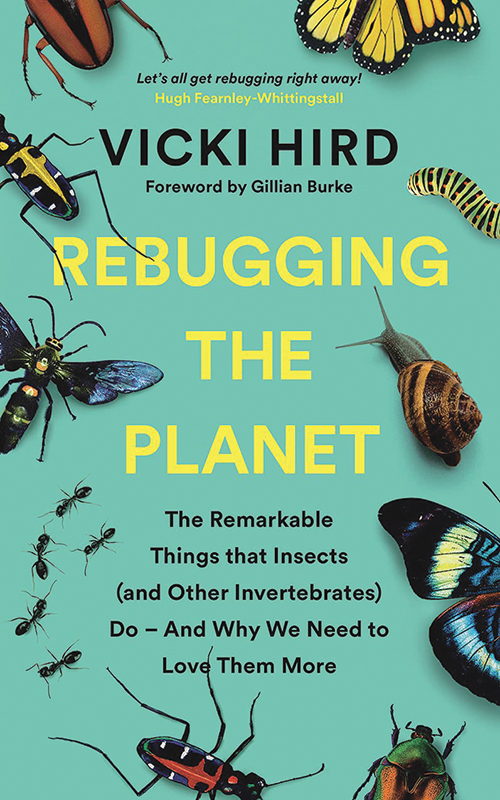
Rebugging the Planet: The Remarkable Things that Insects (and Other Invertebrates) Do—And Why We Need to Love Them More
Reviewed by Brian Drayton
April 1, 2022
By Vicki Hird. Chelsea Green Publishing, 2021. 224 pages. $17.95/paperback or eBook.
This is an enjoyable and useful book. Hird is an environmental activist, educator, and writer, with a particular interest in the intersection of farming, conservation, and policy. Her book engages the reader with natural history, ecology, and practical steps for citizen action.
“Rebugging” is a play on the word “rewilding,” the idea that, for our own welfare and that of the biosphere, many landscapes that have been converted by development of various kinds need to be returned to something like the native state. Rewilding, where it has been successful, is quite a bit more involved than simply letting things “go wild,” since human activities have interrupted or currently prevent many regenerative processes (such as species dispersal) by which pre-human landscapes could rebound from damage by severe events. This is the consequence of the end of nature: In order to reconstruct damaged ecosystems, or support the processes that enable system recovery, humans need to take an active and informed role: “gardening” the world, in a sense.
Hird speaks of “rebugging” because scientists have become aware in recent decades that the invertebrate fauna that is necessary to healthy ecosystems have been dramatically affected by various human activities, resulting in dramatic reductions in population numbers of insects and other creatures as well as significant alterations in seasonal events, nutrient availability, and other impacts. She makes a point of referring in many places to the declines in pollinating species, with potentially catastrophic effects on our food supply, but her view ranges more widely than that.
Chapters 1 and 2 advocate for a wider knowledge of “bugs” (by which she means most terrestrial invertebrates) and their role in ecology, including the ecology of agriculture and land management. Bugs are critical food resources, pollinators, and recyclers in every ecosystem, and they are also fascinating in the wild diversity of their forms, life cycles, and habits. Hird’s style is light and enjoyable, and she mixes anecdote with exposition in a way that will keep the reader engaged. Moreover, she footnotes plenty of references in the scientific or policy literature, so the reader can see what undergirds her narrative.
Chapter 3 connects “rewilding” with “rebugging,” drawing on accumulating evidence that actions that support the return or regeneration of native invertebrates contribute in many ways to the return or regeneration of native plants and larger animals.
In Chapter 4, “Parks and recreation: rebugging your world,” Hird begins to provide the wealth of actions and activism that are available to anyone who wishes to “rebug”—no matter where you live, from the heart of cities to rural/agricultural landscapes. She brings in examples from around the world of experiments and discoveries in rebugging (and thus rewilding and restoring) and offers suggestions that apply at every scale, from the near-home to the regional and beyond.
Chapter 5 widens the focus to address systemic issues, where public policy at the regional, national, and international scale comes into play: climate change, pollution and pesticide abuse, microplastics, and other challenges. These are all matters about which people are already engaged, but the “bug dimension” is often not noted in our focus on charismatic megafauna, like polar bears or Homo sapiens. Yet the megafauna are completely dependent upon the health of the invertebrate fauna of the world, which exists as a complex mosaic, three-dimensional in its interweaving with every kind of organism, in every locale.
Chapters 6-9 bring the reader’s attention in turn to agriculture, politics, long-term resilience (“Imagine a rebugged planet”), and collective action to support the “bugosphere” and the planet as a whole.
Reverence for the earth, and action to ensure a flourishing planet, require us to respect the details, the organisms that occupy Earth with us. For some of you, plants, birds, or the great assemblages of animals on the U.S. prairies or the Serengeti will capture your imagination and move you to the kind of active love that is so urgently needed. But near to home (indeed, within every home, too!) there exists an extravagantly diverse, fascinating, and fundamentally important crowd of organisms—bugs—whose welfare is bound up with yours. Action for bugs can be very local and is within everyone’s reach, but the little critters are part of the whole world system, and Hird’s book is an engaging invitation to see the world in a new way.
Every chapter in this book ends with a substantial list of practical actions, and the book ends with references for further reading and a long catalog of organizations whose work one can join. These reflect the author’s location in the UK, but many have affiliates in the United States, where there are other organizations doing similar work.
Brian Drayton is an ecologist working in science education. He worships with Souhegan Meeting in southern New Hampshire.


